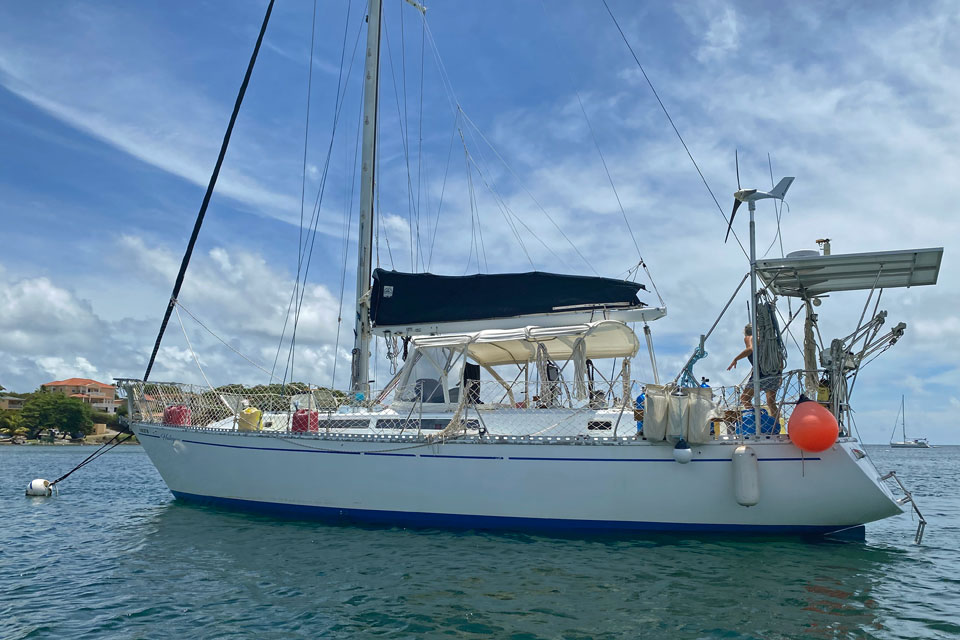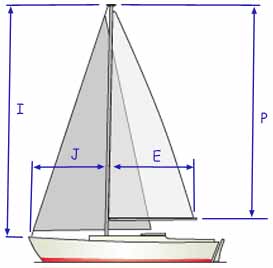- Home
- Cruising Yachts 45' to 50'
- Gulfstar Hirsch 45 Sailboat Specs
The Gulfstar Hirsch 45 Sailboat
Specs & Key Performance Indicators
The Gulfstar Hirsch 45 sailboat, designed by American designers Vince and Richard Lazarra, was built by Gulfstar Yachts in St. Petersburg, Florida.

Published Specification for the Gulfstar Hirsch 45
Keel & Rudder Configuration: Fin keel with spade rudderHull Material: Fiberglass
Length Overall: 13.6 meters (44'8")
Waterline Length: 10.8 meters (35'6")
Beam: 4 meters (13'2")
Draft: 1.7 meters (5'6")
Rig Type: Masthead Sloop
Displacement: 11,793 kilograms (26,000 pounds)
Ballast: 4,309 kilograms (9,500 pounds)
Water Tank Capacity: 530 litres (140 gallons)
Fuel Tank Capacity: 208 litres (55 gallons)
Hull Speed: 14.8 km/h (8 knots)
Designer: Vince & Richard Lazarra
Builder: Gulfstar Yachts
Year First Built: 1985
Year Last Built: 1986
Sail Areas & Rig Dimensions
Sail Area (100%): 64.8m² (697 ft²)
Sail Area Fore: 31.8m² (342.76 ft²)
Sail Area Main: 32.9m² (354.35 ft²)
I: 13.74m (45'1")
J: 4.63m (15'2")
P: 11.37m (37'3")
E: 5.79m (19'0")
Published Design Ratios
The Key Performance Indicators (KPIs)
The following analysis of the design ratios gives an indication of the boat's likely sailing characteristics, but see the 'Notes of Caution' that follow below:
Sail Area to Displacement Ratio (SA/D): 12.76
This ratio is below 16, indicating that the Gulfstar Hirsch 45 is somewhat underpowered. It suggests that the boat is designed more for cruising comfort and stability rather than high-performance sailing. It will likely perform adequately but won't be particularly fast or nimble, especially in light wind conditions.
Ballast to Displacement Ratio (B/D): 36.54%
With a B/D ratio of 36.54%, the Gulfstar Hirsch 45 falls just short of the 40% mark that indicates a very stiff, powerful boat. Nonetheless, it still has a reasonable amount of ballast, suggesting that it should have adequate stability and will manage moderately well in typical cruising conditions.
Displacement to Length Ratio (D/L): 259.44
Falling within the range of 200-275, this ratio categorizes the Gulfstar Hirsch 45 as having a moderate displacement. This means that the boat strikes a balance between carrying capacity and manoeuvrability. It won’t be overly demanding on sail area to reach its hull speed and should handle moderate seas satisfactorily.
Comfort Ratio: 33.91
A comfort ratio in the range of 30 to 40 indicates that the Gulfstar Hirsch 45 will have a reasonably sedate motion. This suggests comfortable motion dynamics in most conditions, making it appropriate for moderate bluewater cruising but not as smooth as much heavier bluewater vessels.
Capsize Screening Formula (CSF): 1.78
The capsize screening value of 1.78 is below the critical value of 2.0, indicating that the Gulfstar Hirsch 45 is well-suited for blue water (ocean) sailing. The lower value suggests good stability and less vulnerability to capsizing in rough seas, which is a positive indicator for safety during long offshore passages.
Summary
Overall, the Gulfstar Hirsch 45 appears to be a well-balanced cruising sailboat. Its design ratios reveal it is somewhat underpowered but stable and comfortable, making it suitable for moderate bluewater cruising rather than high-performance racing. With good motion comfort and a solid safety profile for ocean sailing, this vessel is well-suited for sailors looking for reliable and steady performance on extended voyages.
Here's how to calculate the KPIs yourself - without having to wrestle with the mathematics...
Design Ratios: Notes of Caution...
- The Sail Area/Displacement Ratio (SA/D): This ratio provides an estimate of the sail power relative to the boat's weight, which can indicate potential speed in various wind conditions. But it doesn't account for the efficiency of the sail plan, the rigging, or the skill of the crew. Real-world performance can vary significantly based on these factors.
- The Ballast/Displacement Ratio (B/D): This ratio gives an idea of the boat's stability and stiffness, which is crucial for handling and safety. But it doesn't consider the distribution of the ballast or the hull shape, both of which can greatly affect stability. A high B/D ratio alone doesn't guarantee a stable boat if the ballast is poorly distributed.
- The Displacement/Length Ratio (D/L): This ratio helps predict the boat's speed potential and its behaviour in different sea conditions. But it doesn't account for the hull design or the boat's overall weight distribution. Two boats with the same D/L ratio can perform very differently if their hull shapes are different.
- The Comfort Ratio (CR): This ratio estimates the boat's motion comfort in a seaway, which is important for long passages. But it doesn't consider the boat's interior layout, which can also affect comfort. Additionally, personal tolerance to motion varies, so a boat that is comfortable for one person might not be for another.
- The Capsize Screening Formula (CSF): This formula assesses the likelihood of a boat capsizing in heavy seas, which is critical for offshore safety. But it doesn't take into account the boat's handling characteristics or the skill of the crew. A boat with a low CSF can still capsize if poorly handled in severe conditions.
General Limitations
- Static Nature: These ratios are static measurements and don't account for dynamic factors like wave action, wind gusts, or crew actions.
- Simplification: They simplify complex interactions into single numbers, which can be misleading. Real-world performance is influenced by a multitude of factors that these ratios can't fully capture.
- Context: The context in which the boat is used (e.g., coastal cruising vs. offshore racing) can greatly affect how these ratios should be interpreted.
In summary, while these ratios provide valuable insights into the theoretical performance characteristics of a sailboat, they should be used as part of a broader assessment that includes practical experience, sea trials, and expert advice.
This article was written with the assistance of Gemini, a large language model developed by Google. Gemini was used to gather information, summarize research findings, and provide suggestions for the content and structure of the article.
Recent Articles
-
Is Marine SSB Still Used?
Apr 15, 25 02:05 PM
You'll find the answer to this and other marine SSB-related questions right here... -
Is An SSB Marine Radio Installation Worth Having on Your Sailboat?
Apr 14, 25 02:31 PM
SSB marine radio is expensive to buy and install, but remains the bluewater sailors' favourite means of long-range communication, and here's why -
Correct VHF Radio Procedure: Your Questions Answered
Apr 14, 25 08:37 AM
Got a question about correct VHF radio procedure? Odds are you'll find your answer here...













